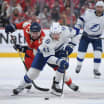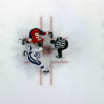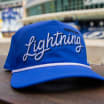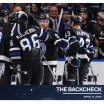Tampa Bay began a four-game road trip in two rinks it's had little regular season success of late, whatever the name of the building.
The Lightning's futility in Washington, D.C. and Pittsburgh continued in back-to-back losses Friday and Saturday night.
Burns: 3 Things from back-to-back losses on the road
Lightning beat writer Bryan Burns recaps the Bolts 5-2 loss to the Penguins

© Joe Sargent
Against the Capitals, Tampa Bay scored on a power play less than 90 seconds into the game but could muster little else in a 3-1 loss to fall to 2-8-0 in their last 10 games at Capital One Arena, formerly the Verizon Center.
A night later in Pittsburgh, the Lightning gave up three 5-on-3 power-play goals and fell behind 4-0 in a game they would eventually lose 5-2. The Bolts are 1-11-1 in their last 13 regular-season visits to PPG Paints Arena.
Tampa Bay will try to regroup for Tuesday's tilt in Buffalo.
Where did it all go wrong in Pittsburgh? We'll break down Saturday night's loss in Three Things we learned from a second-straight defeat
1. GAME-CHANGING SEQUENCE
Despite a couple shaky moments in the first couple minutes, the Tampa Bay Lightning had a solid start to the game after three-straight subpar starts.
They were controlling play in the Penguins' zone, and the chances against Pens' rookie goalie Tristan Jarry were starting to come in bunches.
A four-minute double minor on Jake Guentzel for high-sticking Ondrej Palat seemed to be the break the Lightning needed to unlock Jarry. Palat had the best chance on the double minor, carving out space down low and one-timing Yanni Gourde's behind-the-net pass on frame. Palat, however, wasn't able to get enough lift on the shot, and Jarry slid over to block it with his leg pad.
A few seconds later, Steven Stamkos sent a pass from the left circle just a hair in front of Vladislav Namestnikov on the back post for what would have been an easy tap in.
After those near misses, disaster followed.
With the Bolts' still on the power play, Mikhail Sergachev tried to beat Bryan Rust to a loose puck to keep it in the offensive zone, but Rust was able to touch it first and push it up ahead to start a breakaway. Rust converted shorthanded, and suddenly a Lightning team on the cusp of scoring the game's first goal found themselves demoralized, dejected and trailing 1-0.
A couple minutes later, the Penguins were awarded a four-minute power play of their own when Sidney Crosby was hit with a high stick by Cedric Paquette. Early in the first minor, Anton Stralman tripped Conor Sheary, leading to a long 5-on-3, which the Penguins scored on twice to take a 3-0 lead into the first intermission.
"We had pucks on our stick to clear. We didn't get it down," Lightning head coach Jon Cooper said. "We get that one puck down, and who knows? Maybe we kill this off. All of a sudden, it ends up in the back of the net, they've got momentum, another one goes in and it's too bad."
In the span of about six minutes, the Lightning went from nearly leading 1-0 to trailing 3-0.
They never recovered.
Video: Girardi | Postgame PIT 5, TBL 22. THE DAGGER
Despite trailing 4-1 entering the third period, the Lightning still had a glimmer of hope.
After all, they owned the NHL's top scoring attack and had netted 12 goals in two previous matchups against the Penguins this season.
But less than four minutes into the final period, Mikhail Sergachev took an interference penalty and Dan Girardi was whistled for delay of game 20 seconds later for putting his hand on the puck, giving Pittsburgh yet another 5-on-3 power play.
The Penguins needed just 50 seconds on the two-man advantage to convert, Sidney Crosby netting his second power-play goal of the game, this time with a wrist shot from the right dot to snff any chance of a Lightning comeback bid.
Tampa Bay allowed three power-play goals for the first time this season and the first time since a 4-3 home loss to Pittsburgh last season (Dec. 10).
"You give up three 5-on-3 goals and a shorty, I don't know how many times you can come back from that," Cooper said. "So, that was tough for us."
3. FACING ADVERSITY
Through the first quarter of the season, things had gone pretty smoothly for the Lightning.
They had the best record in the NHL and led the League for goals.
Their goals against was top five in the League.
The Lightning power play produced the most goals in the NHL and was ranked in the League's top three for much of the season. The Bolts penalty kill was improving with each game and was a top 10 NHL unit.
In the first 20 games of the season, the Lightning showed no serious warts, and the wins were piling up rather routinely.
Now, the Lightning have lost two games in a row and have dropped three of their last four contests.
For the first time this season, the Lightning are facing adversity.
How they respond in Buffalo will go a long way in determining what kind of team the Bolts can be this season.
In 2014-15, Tampa Bay never lost more than two games in a row during the regular season, a remarkable streak that propelled them all the way to the Stanley Cup Final.
That same team also lost early season consecutive games in Washington and Pittsburgh and even saw starting goalie Ben Bishop go down with an injury in the Penguins loss. Andrei Vasilevskiy was recalled and made his first NHL start a night later in Philadelphia, making 23-of-24 saves in a 3-1 Lightning win to stop the bleeding.
Can this year's squad show a similar resiliency?
Tuesday's performance against a struggling Buffalo team will be telling.


















